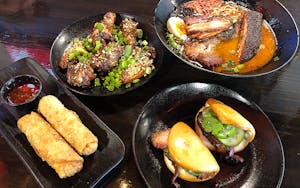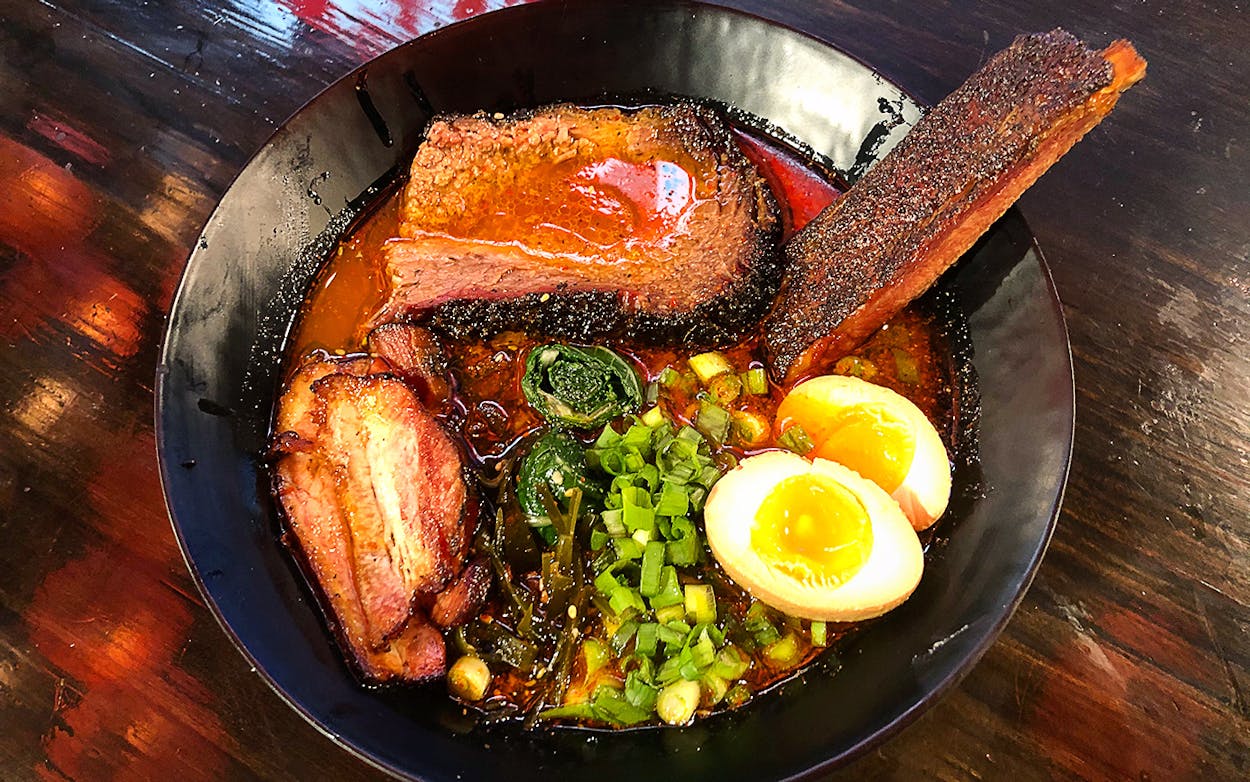Koko Ramen first opened its food truck in 2017. It was a big deal back then to offer barbecue and ramen together in Waco, a city not known for culinary diversity. That’s changed significantly in the last few years. New and exciting restaurants are opening, the barbecue scene has really blossomed, and there’s even a food hall in downtown. Union Hall opened last August and just held its official grand opening. The festivities included an expanded and refined version of chef Cade Mercer’s Koko Ramen, which began serving from its new digs a couple months ago.
They’re still stuffing bao buns with barbecue, offering smoked meat toppers for the ramen, and using ramen noodles from Sun Noodle. But the barbecue options have expanded. A trio of smoked meats, all prepared at Guess Family Barbecue, are available atop a bowl of ramen. Smoked brisket is brought over fresh and sliced for each order (on days when Guess isn’t open, Koko Ramen reheats whole briskets for service). Chilled spare ribs are dunked in the deep fryer, and tender slices of smoked pork belly are grilled before going into the broth. Ask for “all the meats” if you want to get a sampling in one bowl.
A trio of proteins also flavors the broth, which they call “triple stock.” Dried anchovies, pork femurs, and chicken feet, along with a lot of vegetables, seaweed, and mushrooms, simmer together for 24 hours. A vegetarian version made with mushrooms is also available. I tried the tonkotsu broth on my first visit. It’s got an extra richness from paitan, a concentrated tonkotsu stock base that’s added to the triple stock. Mercer uses the Japanese Somi brand of paitan because, he said, “I tried to make it, and every one was not as good as the Asian one.” I asked if it felt like trying to make ketchup better than Heinz. He paused and said, “It’s exactly like that.”
The tonkotsu broth, the most popular dish at Koko Ramen, is substantial. The shoyu broth, flavored with soy sauce, is lighter. I tried them both, but I can’t comment on the flavor of the shoyu since I made the mistake of ordering spice level nine, which is their most punishing. There are only five spice levels available, but the highest is so intense they changed its designation from level five to nine to make sure folks understood what they’d be getting. “It’s almost twice as hot,” Mercer said about the jump up from level four. I can attest that it’s rough to power through the bowl of level nine ramen because the spiciness is dispersed throughout the fatty broth, which is served at an elevated temperature that heightens the burn. Slurping the noodles also aerates and intensifies the spices, and that doesn’t even account for what happens when a stray drop gets in your nose while you’re slurping. Next time I’ll stick with level three or four.

If you’d like to try the level nine spice, they sell small side cups of it for dipping. Just ask. I loved it on the crispy surface of the deep-fried pork rib and on the pork katsu sandwich. Eating the mix of peppers outside the broth allows you to focus on the flavors of the different peppers and what they contribute individually to the whole. Mercer explained that they don’t just add more of the same pepper to achieve the greater levels of spiciness. Levels one and two are made with chile oil and a little sambal. Jalapeño puree is added to that base for level three. Thai chile sauce with Carolina Reaper peppers is used for Level four. The final level gets what Mercer calls a “pepper melody” made from peppercorns. “The pepper will almost rip your tongue,” he said, explaining that it allows the spice to have a greater effect. It also highlights the floral quality of the black pepper in a way that’s sometimes missing in even the most peppery brisket.
At the original Koko Ramen truck, they served more traditional steamed bao. Now they deep-fry the soft buns and stuff them with smoked brisket, pork belly, or pulled rib meat. The finished product isn’t as heavy as it sounds, and the frying means you’ll never end up with a dry bao. A larger sandwich is the previously mentioned pork katsu (a.k.a. tonkatsu), which is a breaded and deep-fried pork cutlet. It comes on a sweet sourdough bun with mayo, cabbage, and pickles. It’s basically a Japanese version of a chicken-fried steak sandwich, and it’s thoroughly satisfying.
There are a few more smoked meats on the appetizer menu as well. Egg rolls are stuffed with pulled pork, but I preferred the brisket rangoons. Chopped brisket replaces the crab in the fried wontons. The chicken wings are also fried, but just for a short time. They start out in the smoker, and the dual cooking methods make for tender meat and crisp skin covered in a sweet and spicy glaze. Dip them in a bit of the level nine hot sauce if you have some on the side.
Mercer has assembled a solid staff at Koko Ramen, with his brother Cody Bevil and friend James Southwick, who both worked with Mercer when he was at EastSide Tavern in Austin (his brisket and cheese tater tots are still on its menu). Mercer does double duty between the Guess Family Barbecue kitchen and Koko Ramen’s. He spends some time at both every day. The thing I love about Guess Family Barbecue is that every element of their menu is well thought out. Every move seems intentional, and that carries over to the Koko Ramen kitchen. Mercer brought in a ramen consultant before reopening just to make sure he got it right. “I’m making a way better product than I was two years ago,” he told me, and after a couple of visits trying nearly the whole menu, he’ll get no argument from me.
Koko Ramen (Inside Union Hall)
720 Franklin Avenue, Waco
Phone: 254-401-1455
Hours: Sun-Thu 11 a.m.-8 p.m., Fri-Sat 11 a.m.-10 p.m.
- More About:
- BBQ Joint Reviews
- Waco








